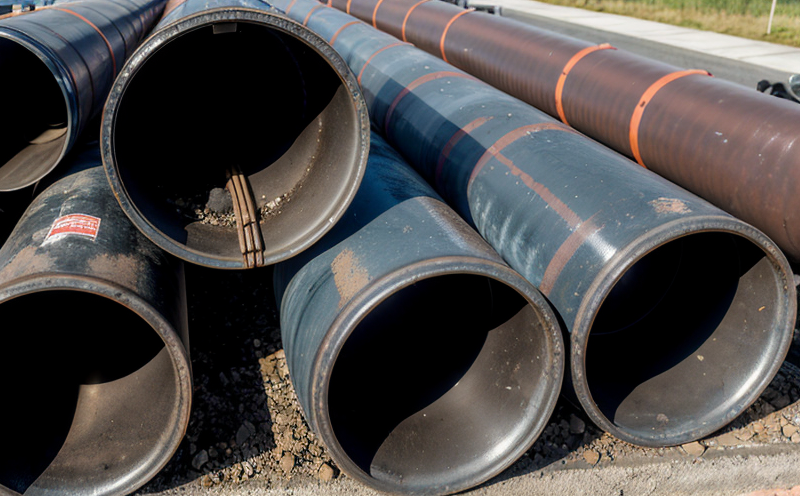BS EN 744 Impact Testing of Thermoplastic Pipes
The BS EN 744 impact testing standard is a critical component in assessing the mechanical properties and durability of thermoplastic pipes. This test evaluates how well the pipe can withstand sudden impacts, which is crucial for ensuring the safety and reliability of plumbing systems, drainage networks, and other infrastructure applications.
This procedure involves subjecting a sample to an impact force from a falling pendulum under controlled conditions. The goal is to determine the energy absorbed by the pipe at the point of impact and its resistance to fracture or deformation. This information helps in selecting appropriate materials for specific environments where thermal, mechanical, and chemical stresses are present.
The test method described in BS EN 744 applies particularly well to thermoplastics due to their unique properties such as flexibility and ease of processing. These characteristics make them ideal candidates for applications requiring flexibility without compromising on strength or durability. However, it's important to note that while this standard focuses primarily on impact resistance, it does not address other mechanical properties like tensile strength or compressive strength.
The process begins with preparing the sample according to the specified dimensions outlined in the standard. Care must be taken during preparation since any deviation could affect the results significantly. Once prepared, the sample is placed in a specially designed fixture that aligns it correctly for impact testing.
During the actual test, a pendulum of known mass swings down and strikes the center of the pipe sample. The height from which it falls determines the amount of kinetic energy imparted to the sample. After striking, the position of the broken part relative to the original length is measured to assess damage. If more than 25% break occurs at the point of impact, this indicates poor resistance to impact forces and suggests further investigation into material composition or manufacturing techniques.
The results from these tests provide valuable insights for manufacturers and designers working within the plumbing industry. They can use this information to improve product design and ensure that their products meet regulatory requirements set forth by relevant authorities.
- Reduction in waste: By improving impact resistance through better manufacturing processes, less material is wasted during production.
- Eco-friendly materials: Thermoplastics used in this testing are often chosen for their recyclability and low environmental impact.
- Sustainable infrastructure: Products that pass these tests contribute to more durable and reliable infrastructure, reducing maintenance costs over time.
In summary, BS EN 744 provides a robust framework for evaluating the impact resistance of thermoplastic pipes. Its implementation ensures that products meet stringent quality standards, thereby enhancing safety and performance across various sectors including residential buildings, commercial complexes, industrial facilities, and public utilities.
Scope and Methodology
The scope of BS EN 744 impact testing encompasses the evaluation of thermoplastic pipes intended for use in water distribution systems. The primary objective is to assess the material's ability to withstand mechanical impacts without failing catastrophically.
To achieve this, a series of tests are conducted using standardized equipment and procedures. A typical setup includes a pendulum mechanism capable of delivering controlled blows to the sample at various heights. Each blow simulates real-world scenarios where pipes might experience sudden external forces such as those caused by vehicles driving over them or accidental drops.
The methodology specifies precise guidelines for sample preparation, including dimensions, weight ranges, and surface finishes. It also details the procedure for attaching samples securely to the pendulum stand before each test run. After striking the pipe, the resulting fracture location is carefully examined to evaluate the extent of damage.
A key aspect of this testing lies in interpreting the outcomes correctly. For instance, if a pipe fails at a specific point along its length after multiple blows, it may indicate localized weaknesses that need addressing during production processes. Conversely, consistent failure patterns elsewhere suggest broader issues related to formulation or processing conditions.
It's worth noting that while BS EN 744 focuses on impact resistance, other properties like dimensional stability and chemical compatibility should also be considered depending upon intended application scenarios.
Industry Applications
The results of BS EN 744 impact testing play a vital role in various industries where thermoplastic pipes are employed. In residential construction, the findings ensure that plumbing systems can handle everyday stresses without compromising safety or longevity.
Commercial establishments benefit from similar guarantees regarding drainage and water supply lines. Hospitals, schools, office buildings—all rely on reliable piping systems to maintain operations uninterrupted by frequent repairs or replacements due to failures caused by impacts.
In the industrial sector, thermoplastic pipes are used extensively for conveying liquids and gases under high pressure conditions. Ensuring these pipes can endure accidental drops or collisions is essential for preventing leaks that could lead to hazardous situations or costly downtime.
For municipalities responsible for maintaining infrastructure such as roadways and bridges, selecting materials based on rigorous testing like BS EN 744 helps reduce maintenance costs while enhancing public safety.
Agricultural facilities also find value in this type of testing since irrigation systems often face harsh environmental conditions. By choosing pipes that meet these standards, farmers can expect more efficient water distribution leading to better crop yields and reduced operational expenses.





